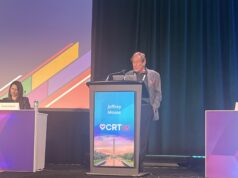
ONYX ONE, the first randomised trial to compare a durable polymer drug-eluting stent to a polymer-free drug-coated stent in patients at high risk of bleeding and treated with one-month dual antiplatelet therapy (DAPT), has found that both are clinically safe and effective.
Stephan Windecker (Swiss Cardiovascular Center, Bern, Switzerland) reported the findings at late-breaking session at the Transcatheter Cardiovascular Therapeutics scientific symposium (TCT 2019; 25–29 September, San Francisco, USA).
Up to 40% of patients undergoing PCI have high bleeding risk (HBR) characteristics and current guidelines recommend three to six months of DAPT for high bleeding risk patients undergoing PCI, with consideration for DAPT duration as short as one month in selected patients. However, randomised data with shorter durations of DAPT are scarce, particularly for current generation polymer-based DES.
Windecker explained: “LEADERS FREE established the superiority of a polymer-free biolimus-A9 coated stents (BioFreedom) over otherwise identical bare metal stents in terms of both safety and effectiveness in high bleeding risk patients treated with one-month DAPT. But the current generation of polymer-based drug eluting stents have not been compared to polymer-free drug-coated stents in high bleeding risk patients treated with one-month DAPT.”
The objective of the Onyx ONE trial was to compare a polymer-based zotarolimus eluting stent (ZES; Resolute Onyx, Medtronic) to a polymer-free biolimus A-9 drug-coated stent (DCS; BioFreedom) in HBR patients with planned one-month DAPT (aspirin and an oral P2Y12 inhibitor).
The prospective, multicentre, single-blind trial enrolled 2,000 HBR patients who were randomized 1:1 at 84 global sites. The primary safety endpoint was cardiac death, myocardial infarction (MI), or definite/probable stent thrombosis at one year. The powered secondary endpoint was target lesion failure, a composite of cardiac death, target vessel myocardial infarction, or clinically driven target lesion revascularisation. Other secondary endpoints included device and procedure success rates, BARC bleeding, and the individual components of the primary endpoints.
Of the 1,996 patients randomised, one-year follow-up was available in 98.5% (n=988) of the ZES arm and 97.6% (n=969) of the DCS arm. Baseline and lesion characteristics were similar among both groups. Crossover to an alternative stent occurred more frequently in the DCS arm (40 vs. 2, p<0.001), and ZES showed improved angiographic outcomes, resulting in greater device success post-PCI (92.8% for ZES and 89.7% for DCS, p=0.007). At two months post-PCI, 92% of patients were on single antiplatelet therapy and 88% were at one year. The primary safety endpoint of cardiac death, MI, or definite/probable stent thrombosis at one year was 17.1% for ZES and 16.9% for DCS (P noninferiority=0.011). In addition, the powered secondary effectiveness endpoint of target lesion failure at one year was 18% for ZES and 17.9% for DCS (hazard ratio [HR] 1.02, 95% confidence interval [CI] 0.83–1.26, p=0.84). Bleeding rates were also similar among both treatment groups.
Windecker said: “Among high bleeding risk patients treated with one-month DAPT after PCI, Resolute Onyx was as safe and effective as BioFreedom. Resolute Onyx had improved angiographic outcomes and greater device success post-PCI.”













